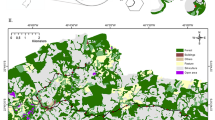Abstract
The effects of isolation-related and vegetational parameters on presence and relative abundance of snakes in patchy forested fragments of Mediterranean central Italy are studied. The most abundant species was Coluber viridiflavus (accounting for 47.7% of the total snake sample observed) followed by Vipera aspis (22%), Elaphe longissima (21.5%), Natrix natrix (7.7%), and Coronella austriaca (1.1%). There was a clear trend for bigger species to be less distributed among the various forest fragments than the smaller species. Presence of Coluber viridiflavus, Coronella austriaca and Natrix natrix was not influenced by woodland area, whereas that of Vipera aspis and Elaphe longissima was positively influenced by woodland area. Woodland isolation parameters did not influence the presence of Coluber viridiflavus, Coronella austriaca and Natrix natrix, but of Vipera aspis and Elaphe longissima. Discriminant stepwise analysis suggested that specific environmental features influenced the occurrence and abundance of the various snake species, Vipera aspis being the taxon more affected by isolation-related parameters. Some conservation implications of our observations are also discussed.
Similar content being viewed by others
References
Andrén, H. (1994) Effects of habitat fragmentation on birds and mammals in landscapes with different proportions of suitable habitat: a review. Oikos 71, 355–66.
Anglestam, P. (1992) Conservation of communities — the importance of edges, surroundings and landscape mosaic structure. In Ecological principles of nature conservation: application in temperate and boreal environments (L. Hansson, ed.) pp. 9–70. London: Elsevier.
Balletto, E. and Giacoma, C. (1993a) Struttura di popolazione e probabilità di sopravvivenza a medio termine in alcune specie di anfibi. Suppl. Ric. Biol. Selvaggina 21, 135–50.
Balletto, E. and Giacoma, C. (1993b) Stochastic extinction probability for European populations of Hyla arborea: an approach by VORTEX. In Ecology and conservation of the European tree frog (A.M.T. Stumpel and U. Tester, eds) pp. 81–90. Potsdam.
Beier, P. (1993) Determining minimum habitat areas and habitat corridors for Cougars. Conserv. Biol. 7, 94–108.
Boorman, S.A. and Levitt, P.R. (1973) Group selection on the boundary of a stable population. Theor. Popul. Biol. 4, 85–128.
Bright, P.W., Mitchell, P. and Morris, P.A. (1994) Dormouse distribution: survey techniques, insular ecology and selection of sites for conservation. J. Appl. Ecol. 31, 329–39.
Bruno, S. and Maugeri, S. (1990) Serpenti d'Italia e d'Europa. Milano: Editoriale Giorgio Mondadori.
Capizzi, D., Luiselli, L., Capula, M. and Rugiero, L. (1995) Feeding habits of a Mediterranean community of snakes in relation to prey availability. Rev. Ecol. (Terre et vie) 50, 353–363.
Capizzi, D. and Luiselli, L. (1996a) Feeding relationships and competitive interactions between phylogenetically unrelated predators (owls and snakes). Acta Oecol. 17, 265–84.
Capizzi, D. and Luiselli, L. (1996b) Ecological relationships between small mammals and age of coppice in an oak-mixed forest in central Italy. Rev. Ecol. (Terre et Vie) 51, 277–91.
Capula, M. and Luiselli, L. (1994) Omaggio a Whitney Houston (e alle femmine nere nelle popolazioni naturali): selezione sessuale e determinanti del successo riproduttivo nel marasso (Vipera berus), Atti I Conv. Erpetol. Montana, pp. 90–7.
Corbett, K. (1989) Conservation of European reptiles and amphibians. London: C. Helm.
Dodd, C.K. Jr (1993) Strategies for snake conservation. In Snakes — Ecology & Behavior (R.A. Seigel and J.T. Collins, ed) pp. 363–94. New York: McGraw-Hill Inc.
Ehrlich, P.R. and Wilson, E.O. (1991) Biodiversity studies: science and policy. Science 253, 758–62.
Filippi, E. (1995) Aspetti dell'ecologia di due comunità di colubridi e viperidi (Reptilia: Serpentes) in un' area dell' Italia centrale (Monti della Tolfa, Lazio). Unpublished MS Thesis, University of Rome ‘La Sapienza’, Rome, Italy.
Gibbons, J.W. and Semlitsch, R.D. (1987) Activity patterns. In Snakes — Ecology and evolutionary biology (R.A. Seigel, J.T. Collins and S.S. Novak, eds) pp. 396–421. New York: Macmillan publishing company.
Goddard, P. and Spellerberg, I.F. (1980) Reproduction as a factor in the conservation of Coronella austriaca Laur. in southern England. Bull. Ecol. 11, 535–41.
Hinsley, S.A., Bellamy, P.E., Newton, I. and Sparks, T.H. (1996) Influences of population size and woodland area on bird species distributions in small woods. Oecologia 105, 100–6.
Luiselli, L. (1996) Individual success in mating balls of the grass snake, Natrix natrix: size is important. J. Zool. (Lond.) 239, 731–40.
Luiselli, L., Capizzi, D., Capula, M. and Rugiero, L. (1994) Predator-prey relationships between snakes and small mammals in forestry habitats of central Italy. Joint Meeting Herpetologists' League & Society for the Study of Amphibians & Reptiles (Abstracts).
Madsen, T., Shine, R., Loman, J. and Hakansson, T. (1993) Determinants of mating success in male adders, Vipera berus. Anim. Behav. 45, 491–9.
Rugiero, L. and Luiselli, L. (1996) Ecological notes on an isolated population of Elaphe quatuorlineata. Herpetol. J. 6, 93–5.
Saint Girons, H. (1996) Structure et évolution d'une petite population de Vipera aspis (L.) dans une région de bocage de l'ouest de la France. Rev. Ecol. (Terre et Vie) 51, 223–41.
Shine, R., Madsen, T., Luiselli, L. and Capula, M. (1997) Does multiple mating by a female adder influence the viability of her offspring? Evolution, in press.
Simpson, E.H. (1949) Measurement of diversity. Nature (Lond.) 163, 688.
Spellerberg, I.F. (1977) Behaviour of a young smooth snake, Coronella austriaca Laurenti. Biol. J. Linn. Soc. 9, 323–30.
Spellerberg, I.F. (1982) The secretive smooth snake. The living Countryside 6(64), 1261–3.
Spellerberg, I.F. (1987) Management of forest habitats for reptiles. In Wildlife management in forests (D.C. Jardine, ed.) pp. 83–91. Lancaster: University of Lancaster Press.
Spellerberg, I.F. (1988) Ecology and management of reptile populations in forests. Quarterly J. Forestry 82, 99–109.
Townsend, C.R. and Crowl, T.A. (1991) Fragmented population structure in a native New Zealand fish: an effect of introduced brown trout? Oikos 61, 347–54.
Wilson, E.O. (1992) The diversity of life. London: Allen Lane.
Zar, J.H. (1984) Biostatistical analysis. New Jersey: Prentice Hall.
Author information
Authors and Affiliations
Rights and permissions
About this article
Cite this article
LUISELLI, L., CAPIZZI, D. Influences of area, isolation and habitat features on distribution of snakes in Mediterranean fragmented woodlands. Biodiversity and Conservation 6, 1339–1351 (1997). https://doi.org/10.1023/A:1018333512693
Issue Date:
DOI: https://doi.org/10.1023/A:1018333512693




